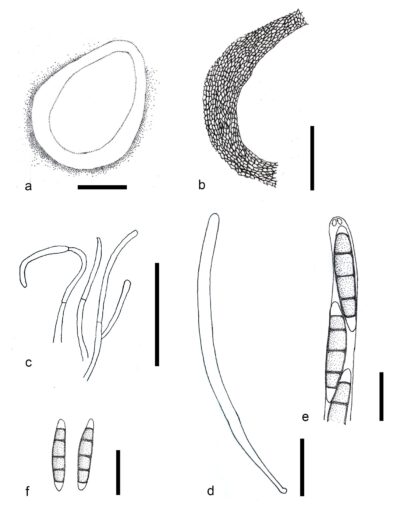Fungalpedia – Note 283, Pseudoascotaiwania
Pseudoascotaiwania Jing Yang, Bhat & K.D. Hyde
Citation when using this entry: Perera et al. 2024 (in prep) – Fungalpedia, genera described in 2016.
Index Fungorum, Facesoffungi, MycoBank, GenBank, Fig. 1
Classification: Fuscosporellaceae, Fuscosporellales, Hypocreomycetidae, Sordariomycetes, Pezizomycotina, Ascomycota, Fungi
Yang et al. (2016) introduced the monotypic genus Pseudoascotaiwania based on a combined LSU, SSU, and rpb2 phylogeny to accommodate Ascotaiwania persoonii, which clusters distant from the type species of Ascotaiwania (Fallah et al. 1999). Pseudoascotaiwania persoonii is saprobic on twigs in freshwater habitats (Fallah et al. 1999; Yang et al. 2016). The genus is characterized by scattered, immersed, black, urniform, rostrate, and membranous ascomata. Simple septate periphyses lining the beaked ostiolar canal. The peridium is several layers thick and brown with an angularis texture. Paraphyses are simple or branched. The asci are arranged in a broad hymenium. They are unitunicate, cylindrical, 8-spored, persistent with a long stalk and an apical ring that is stained blue in aqueous cotton blue. Ascospores are uniseriate, septate, pale to light brown, and cylindrical to fusoid with acute or rounded ends (Yang et al. 2016). The asexual morph is undetermined.
Type species: Pseudoascotaiwania persoonii (Fallah, J.L. Crane & Shearer) Jing Yang, Bhat & K.D. Hyde
Other accepted species: This genus is monotypic
Figure 1 – Pseudoascotaiwania persoonii (ILLS 52298, holotype). a Median longitudinal section through ascoma. b Peridium. c Paraphyses. d Ascus. e Apical ring. f Ascospores. Scale bars: a, b = 100 μm, c, e, f = 25 μm, d = 50 μm. Redrawn from Fallah et al. (1999).
References
Entry by
Rekhani Hansika Perera, Center of Excellence in Fungal Research, Mae Fah Luang University, Chiang Rai, 57100, Thailand.
(Edited by Kevin D. Hyde, Samaneh Chaharmiri-Dokhaharani, & Achala R. Rathnayaka)
Published online 28 May 2024
